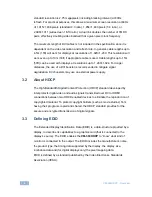
VM-300HDCP - Overview
3
3
3
Overview
The high quality
VM-300HDCP
accepts an HDMI signal and distributes the
selected signal to up to three outputs over DVI connectors.
The
VM-300HDCP
features:
•
Support for up to 1.65Gbps bandwidth per graphic channel
•
I-EDIDPro™ Kramer Intelligent EDID Processing™ – Intelligent EDID
handling & processing algorithm ensures Plug and Play operation for
DVI/HDMI systems
•
Support for HDCP signals
•
Equalization and reclocking of the data
•
The ability to use a default EDID or acquire the EDID from one output or
from all connected outputs (Auto-mix)
•
A MegaTOOLS
®
sized enclosure. The device can be mounted in a rack
using the optional
RK-T2B
adapter
3.1
About DVI–General Description
The Digital Visual Interface (DVI) is a video interface standard covering the
transmission of video between a source device (such as a personal computer) and
a display device. DVI is designed to carry uncompressed digital video data to a
display. It is partially compatible with the HDMI (High-Definition Multimedia
Interface) standard in digital mode (DVI-D), and VGA in analog mode (DVI-A).
A single-link DVI connection consists of four TMDS links; each link transmits data
from the source to the device over 1 twisted wire pair. Three of the links
correspond to the RGB components of the video signal: red, green, blue (for a
total of 24 bits per pixel.) The fourth link carries the pixel clock. Each TMDS link
carries binary data at ten times the pixel clock reference frequency, for a
maximum data rate of 1.65Gbps × 3 data pairs for single-link DVI.
The DVI specification mandates a maximum pixel clock frequency of 165MHz
when running in single-link mode. With a single DVI link, the highest supported


































